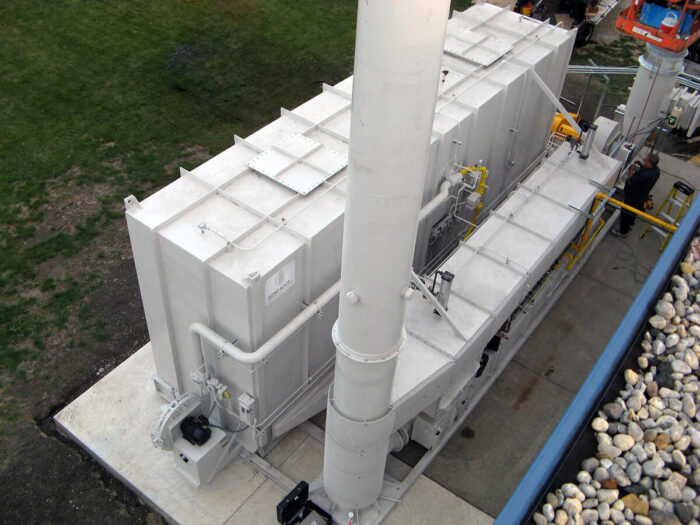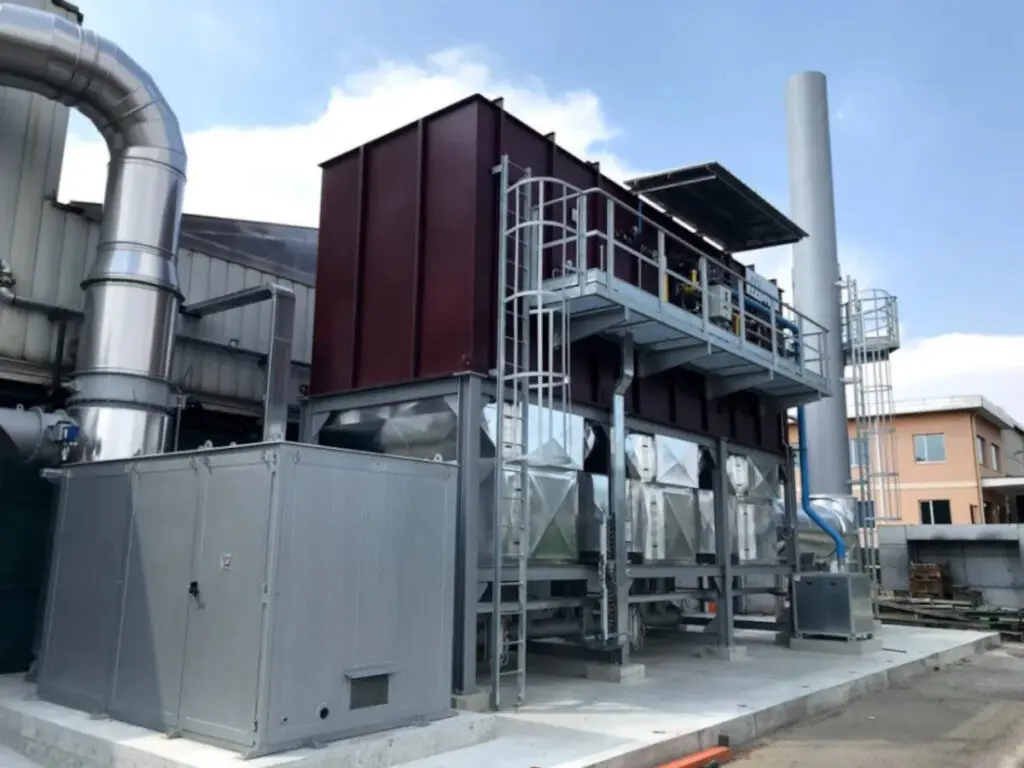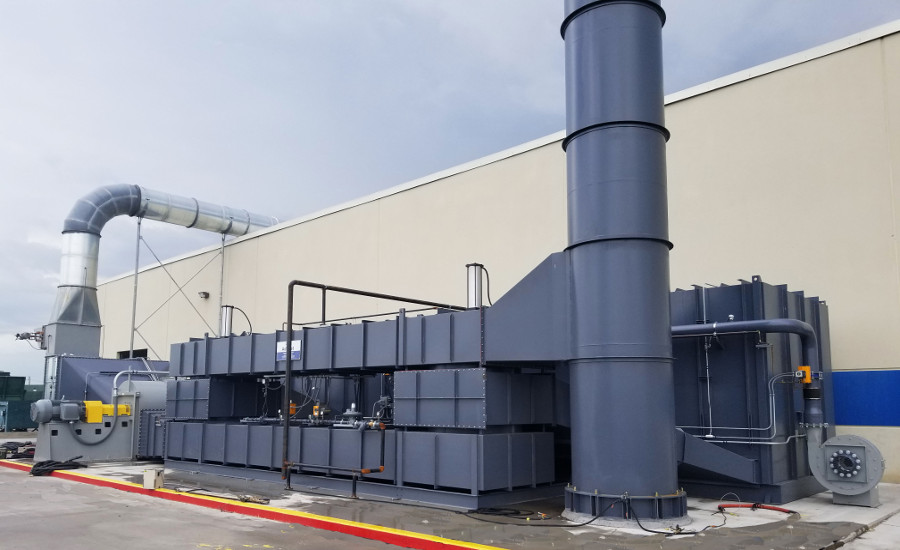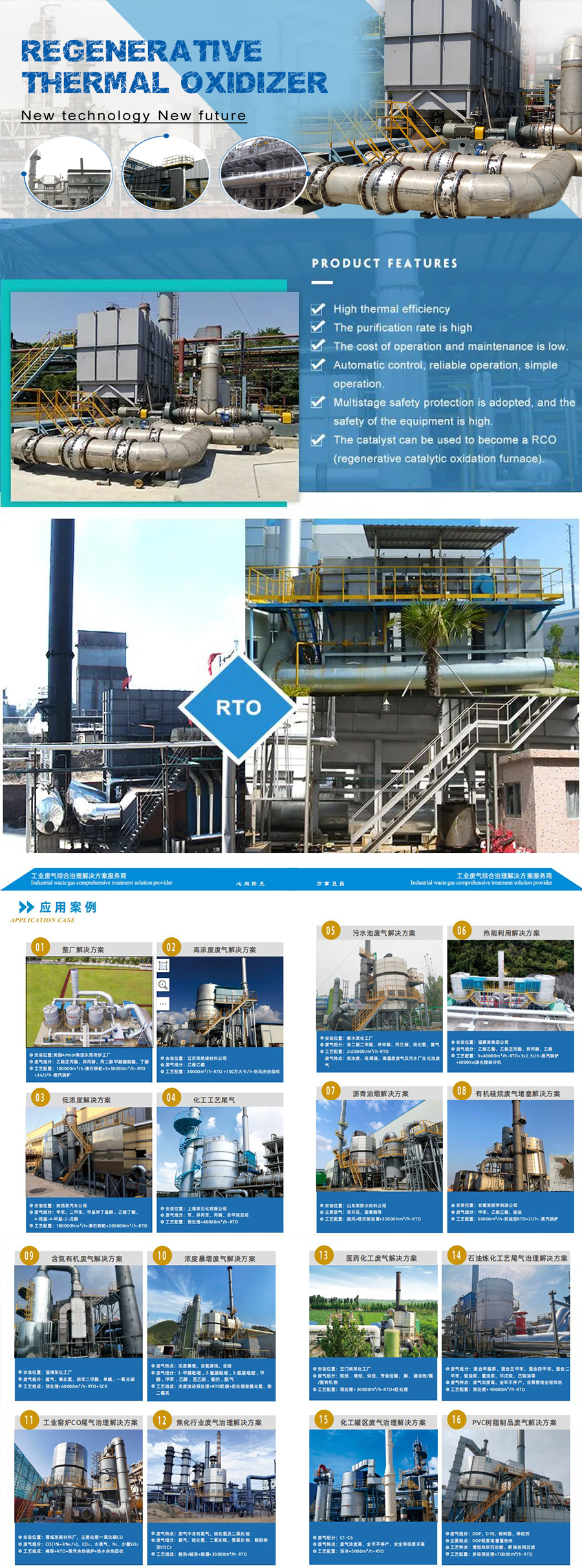Основна информация.
Модел NO.
RTO
Тип
Environmental Monitoring Instrument
Main Function
Waste Gases Removal
Application
Chemical Industry
Brand
Raidsant
Clean Efficeincy
99.8%
Condition
New
Търговска марка
Raidsant
Транспортен пакет
Film Wrapped
Произход
ZheJiang China
Описание на продукта
HangZhou Raidsant Machinery Co.;,; Ltd.; is majored in developing and manufacturing innovativepowder cooling pelletizing machinery and related industrial waste gas treatment machine.; With nearly 20 years’ production history,; we have a good market in more than 20 provinces in China,; and some of our products were exported to Saudi Arabia,;Singapore,;Mexico,; Brazil,;Spain,; America,; Russia and Korea,; etc.;
Specifications:;
* More compact than the existing facilities
* Low-operation costs
* Long lifespan of facilities
* No changes in pressure
Purpose:;
Energy-saving system that burns volatile organic compound (VOC); and waste gas by using heat,; and it collects over 99.;8% of waste heat of exhaust gas by using ceramic regenerative materials (catalyst); with large surface area and low-pressure loss.;
Applications:;
1.; Painting drying process
2.; metal printing process
3.; fiber drying process
4.; adhesive tape process
5.; waste treatment process
6.; semiconductor manufacturing process
7.; smoke,; confectionary and baking process
8.; petrochemical process,;
9.; medicine and food manufacturing process,;
10.; other VOC generating process
Merits:;
* More compact than the existing facilities
* No changes in pressure
* High-heat recovery rate (over 95%);
* Perfect VOC treatment (over 99.;8%);
* Long lifespan of facilities
* Low-operation costs
* Able to be manufactured in circle or quadrangle
General Descriptions and Features:;
1.; Operating principle
Operation method that continuously changing discharges by rotating the Rotary Valve
2.; Process Pressure Change
No pressure change because wind direction changes in order by the Rotary Valve rotation
3.; Investment Costs
Around 70% of Bed Type
4.; Installation Space
It is single vessel so it is compact and requires less installation space.;
5.; Maintenance
It is easy to maintain it because Rotary Valve is the only 1 moving part.;
Rotary Valve’s sealing part is rarely worn out because it rotates at low speed.;
6.; Stability
No risks in the process because it is always opened even when the Rotary Valve has troubles.;
7.; Treatment Efficiency
Treatment efficiency maintains because sealing part is rarely worn out even if it is operated for a long time.;
Address: No.3,Zhenxin Middle Road, Economic Development Zone,HangZhou,ZheJiang
Тип бизнес: производител/фабрика, търговска компания
Business Range: Chemicals, Electrical & Electronics, Manufacturing & Processing Machinery, Security & Protection
Management System Certification: ISO 9001
Main Products: Pelletizer, Flaker, Pastillator, Granulator, Chemical Pelletizer, Vocs
Company Introduction: HangZhou Raidsant Machinery Co., Ltd. ., previously called HangZhou Xinte Plastic Machinery Factory is majored in producing innovative plastic recycling machinery. With nearly 20 years′ experience, we have a good market in 20 provinces in China, and some of our products were exported to Indonesia, Russia and Vietnam, etc. Our main products include DZ Type Pastillator, waste tire recycling line, Big Calibre Plastic Pipe shredders recycling line, continuous annealing tin-coation machine, QX type PET, PE & hull washing line, SDP double rails plastic recycling crusher, SJ hot cutting granule making unit, PVC tube (cinquefoil) product line, PVC Odd-shaped material product line for door and window, granule product line in water and Shredder for plastics and recycling. We acquired 5 technical patents.
Our corpotation lays emphsis on thchnical reconstruction, imports advanced technology from home and abroad, and develops new products constantly. Our tenet is challenging for hight quality, offering the best products. We are making efforts to realize our slogan. Satisfying our customers is our everlasting pursuit.
We are looking for the oversea customers or agents. If you are interested in our proposal, please let us know which of our products is the most likely to appeal to you or your customers. We should be very grateful if you give us some ideas of the marketprospects for our products. We hope to hear favorable information from you soon! It is our goal that we wish we could buid a good relationship with you now or in the near future. Please do not hesitate to contact us if you have any question or request.
We also sincerely welcome you to our company to discuss business and negotiate with us. For further expanding our market and customers, our company welcomes customer from domestic and aboard in an new-brand gesture on the basis of full-new mangement conception—quality, honour, service. We are looking for ISO 90001 mangement quality system to meet with our customers requirement!

What are the limitations of regenerative thermal oxidizers?
While regenerative thermal oxidizers (RTOs) are widely used for air pollution control, they do have certain limitations that should be considered. Here are some key limitations of RTOs:
- High Capital Cost: RTOs typically have higher capital costs compared to other air pollution control technologies. The complexity of the regenerative heat exchanger system, which enables high energy efficiency, can contribute to the higher upfront investment required for RTO installation.
- Space Requirements: RTOs generally require a larger footprint compared to some other air pollution control devices. The presence of regenerative heat exchangers, combustion chambers, and associated equipment necessitates adequate space for installation. This can be a limitation for industries with limited available space.
- High Energy Consumption during Startup: RTOs require a certain amount of time and energy to reach their optimal operating temperature during startup. This initial energy consumption can be relatively high, and it is important to consider this aspect when planning the operational schedule and energy management of an RTO system.
- Limitations in Handling Low Concentration VOCs: RTOs may have limitations in effectively treating low concentration volatile organic compounds (VOCs). If the VOC concentrations in the exhaust gas are too low, the energy required to maintain the necessary temperature for oxidation may be higher than the energy released during the combustion process. In such cases, other air pollution control technologies or pre-concentration techniques may be more suitable.
- Particulate Matter Control: RTOs are not specifically designed for controlling particulate matter emissions. While they may provide some incidental removal of fine particulate matter, their removal efficiency for particulates is generally lower compared to dedicated particulate control devices such as fabric filters (baghouses) or electrostatic precipitators.
- Chemically Corrosive Gases: RTOs may not be suitable for treating exhaust gases containing highly corrosive compounds. The high temperatures within the RTO can accelerate corrosion of materials, and the presence of corrosive gases may require additional corrosion-resistant materials or alternative air pollution control technologies.
Despite these limitations, RTOs remain an effective and widely used technology for the destruction of gaseous pollutants in various industrial applications. It is important to evaluate the specific requirements, characteristics of the exhaust gases, and environmental regulations when considering the implementation of an RTO system.

What are the typical construction materials used in regenerative thermal oxidizers?
Regenerative thermal oxidizers (RTOs) are constructed using various materials that can withstand the high temperatures, corrosive environments, and mechanical stresses encountered during operation. The choice of materials depends on factors such as the specific design, process conditions, and the types of pollutants being treated. Here are some typical construction materials used in RTOs:
- Heat Exchangers: The heat exchangers in RTOs are responsible for transferring heat from the outgoing exhaust gas to the incoming process air or gas stream. The construction materials for heat exchangers often include:
- Ceramic Media: RTOs commonly use structured ceramic media, such as ceramic monoliths or ceramic saddles. These materials have excellent thermal properties, high resistance to thermal shock, and good chemical resistance. Ceramic media provide a large surface area for efficient heat transfer.
- Metallic Media: Some RTO designs may incorporate metallic heat exchangers made from alloys such as stainless steel or other heat-resistant metals. Metallic media offer robustness and durability, particularly in applications with high mechanical stresses or corrosive environments.
- Combustion Chamber: The combustion chamber of an RTO is where the oxidation of pollutants takes place. The construction materials for the combustion chamber should be able to withstand the high temperatures and corrosive conditions. Commonly used materials include:
- Refractory Lining: RTOs often have refractory lining in the combustion chamber to provide thermal insulation and protection. Refractory materials, such as high-alumina or silicon carbide, are chosen for their high-temperature resistance and chemical stability.
- Steel or Alloys: The structural components of the combustion chamber, such as the walls, roof, and floor, are typically made of steel or heat-resistant alloys. These materials offer strength and stability while withstanding the high temperatures and corrosive gases.
- Ductwork and Piping: The ductwork and piping in an RTO transport the exhaust gas, process air, and auxiliary gases. The materials used for ductwork and piping depend on the specific requirements, but commonly used materials include:
- Mild Steel: Mild steel is often used for ductwork and piping in less corrosive environments. It provides strength and cost-effectiveness.
- Stainless Steel: In applications where corrosion resistance is crucial, stainless steel, such as 304 or 316 grades, may be used. Stainless steel offers excellent resistance to many corrosive gases and environments.
- Corrosion-Resistant Alloys: In highly corrosive environments, corrosion-resistant alloys like Hastelloy or Inconel may be employed. These materials provide exceptional resistance to a wide range of corrosive chemicals and gases.
- Insulation: Insulation materials are used to minimize heat loss from the RTO and ensure energy efficiency. Common insulation materials include:
- Ceramic Fiber: Ceramic fiber insulation offers excellent thermal resistance and low thermal conductivity. It is often used in RTOs to reduce heat loss and improve overall energy efficiency.
- Mineral Wool: Mineral wool insulation provides good thermal insulation and sound absorption properties. It is commonly used in RTOs to reduce heat loss and enhance safety.
It is important to note that the specific materials used in RTO construction may vary depending on factors such as the process requirements, temperature range, and corrosive nature of the gases being treated. Manufacturers of RTOs typically select appropriate materials based on their expertise and the specific application.

Can regenerative thermal oxidizers reduce odor emissions?
Regenerative thermal oxidizers (RTOs) are effective in reducing odor emissions from industrial processes. While their primary purpose is to control and destroy volatile organic compounds (VOCs) and hazardous air pollutants (HAPs), they can also effectively mitigate odorous compounds.
Here’s how RTOs contribute to odor reduction:
- Oxidation of Odorous Compounds: RTOs operate at high temperatures, typically ranging from 1,400 to 1,800 degrees Fahrenheit (760 to 980 degrees Celsius). These elevated temperatures facilitate the complete oxidation of odorous compounds, breaking them down into harmless byproducts, such as carbon dioxide and water vapor. The thermal oxidation process ensures the destruction of odor-causing molecules.
- High Destruction Efficiency: RTOs are designed to achieve high destruction efficiencies, often exceeding 99%. This means that the vast majority of odorous compounds are effectively eliminated during the combustion process, resulting in a significant reduction in odor emissions.
- Retention Time: RTOs provide a sufficiently long retention time for the exhaust gases within the combustion chamber. This allows for thorough mixing and residence time necessary for the complete oxidation of odorous compounds. The extended contact time ensures that the odorous molecules have sufficient exposure to the high temperatures, resulting in their destruction.
- Control of VOCs: Many odorous compounds are also VOCs. By effectively controlling and destroying VOC emissions, RTOs indirectly reduce odor emissions as well. The comprehensive destruction of VOCs prevents their release into the atmosphere, thereby minimizing the associated odors.
- Monitoring and Optimization: Proper monitoring and optimization of RTO operation can further enhance odor reduction. By continuously monitoring the process parameters, such as temperature, airflow, and pollutant concentrations, adjustments can be made to optimize the performance of the RTO and ensure effective odor control.
It’s important to note that while RTOs are effective in reducing odor emissions, the specific odor compounds and their concentrations in the exhaust stream can influence the overall odor control efficiency. Additionally, proper design, operation, and maintenance of the RTO are crucial for achieving optimal odor reduction.

editor by Dream 2024-12-02
